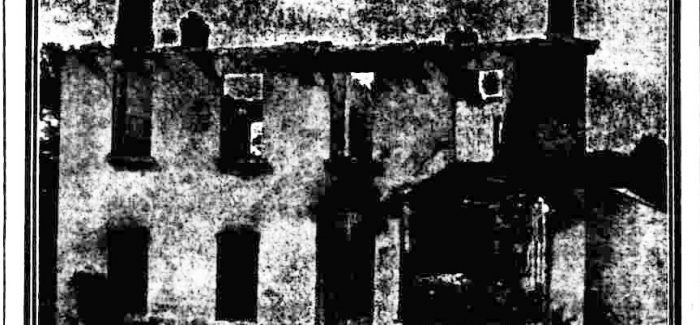Torching of Ballybrack RIC Barracks May 1920
| Name | Ballybrack RIC Barracks |
|---|---|
| Address | Wyattville Road, Ballybrack |
| On 1888 map | Yes |
On 12th May 1920, 101 years ago this month (May 2021), the country was in the throes of the War of Independence. The campaign being waged by the IRA had spread to many parts of the country and South County Dublin was not spared. The attacks on RIC police barracks and other buildings representing the establishment was escalating and on the night of 12th May a series of well-planned co-ordinated attacks on a number of targets, including the RIC barracks at Ballybrack, Blanchardstown, Bessborough, Crumlin and Kill o’ the Grange, took place. Although meticulously planned the Ballybrack attack ended tragically with the death of a local resident and two of the Volunteers. The barracks, which was located on Wyattville Road, was completely destroyed.

Although not entirely specific to Killiney, the boundaries between Killiney and Ballybrack being somewhat blurred, we have transcribed and reproduce here a number of newspaper articles as many individuals and houses which were central to this story are of Killiney. Thanks to Anthony Deegan of Glenalua Road for bringing this story to our attention.
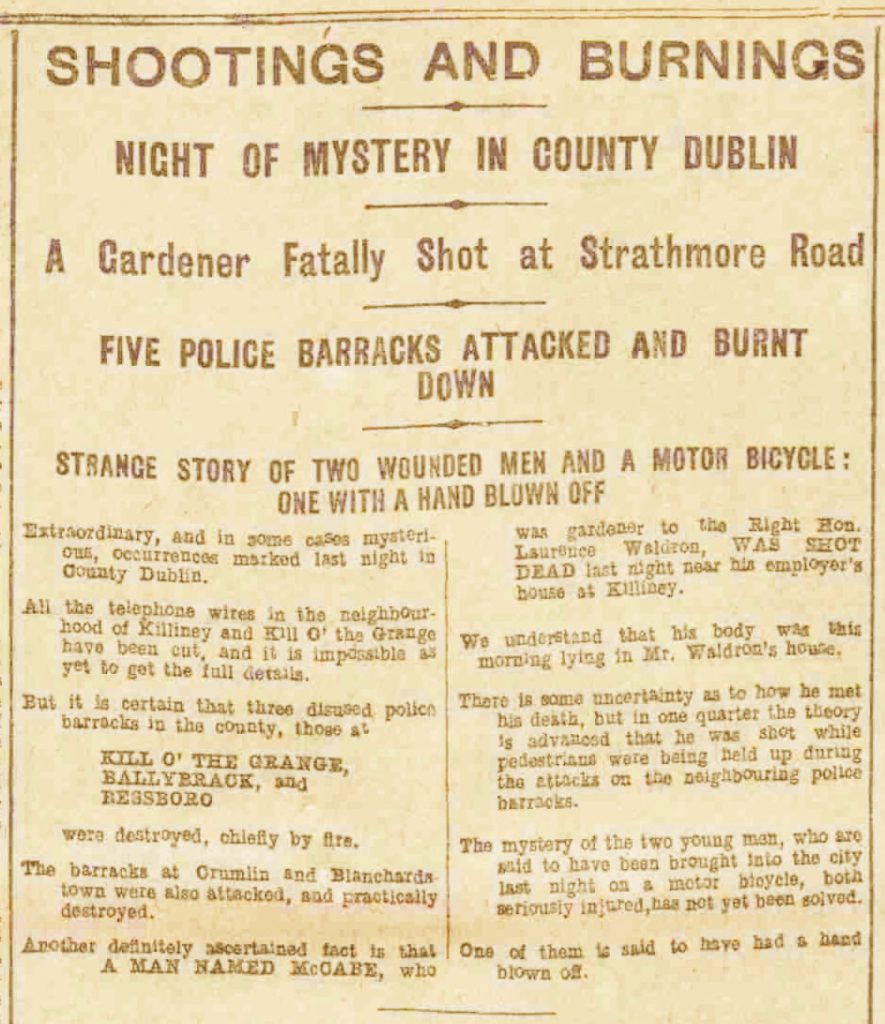
Report of the incident as it appeared in the Irish Independent on 14th May 1920
The article transcribed below which appeared in the Irish Independent on the 14th of May 1920 is the most detailed and comprehensive record of events which occurred.
Big Cordon Round Killiney. A cordon was apparently drawn round a very wide area around Ballybrack and Killiney, where all wires were cut and the destruction of the barracks there, as well as at Kill O’ the Grange and Blanchardstown was carried out with great coolness, method and celerity.
Cool & Swift Operation. The destruction of the Ballybrack Barrack was carried out in a cool and daring manner. Over a year ago the police were withdrawn from the barrack and transferred to Cabinteely but Mrs Hurst, the wife of Sergeant Hurst, and four of her family resided in the house. The building was a fine detached two story one, on the Wyatville Road leading from Ballybrack to Loughlinstown village. About 10:00 o’clock it would seem that a cordon of scouts was thrown around the district, from Killiney Hill village in a circle to Loughlinstown, and thence to Ballybrack. They carried revolvers and whilst many wore masks others were not disguised. All pedestrians, cyclists, motor cars and other vehicles were held up until the work of destruction was complete and then, with apologies for inconvenience caused, they were told they could go.
Hay and Petrol Commandeered. About 10:00 o’clock seven young men knocked at the grocery establishment of Messers. Edwards and Co., Ballybrack. The assistants were out and the housekeeper opened the door. Several men walked in and took away tins of petrol. The housekeeper became so alarmed at their action that she ran out of the place. Other young men entered Mr. Reilly’s haggard and took away hay. At the sound of a whistle nearby 30 men surrounded the barrack, and having warned the occupants, proceeded to set it on fire using the petrol and hay to hasten the destruction. The building was completely destroyed, only four blackened walls now remain standing.
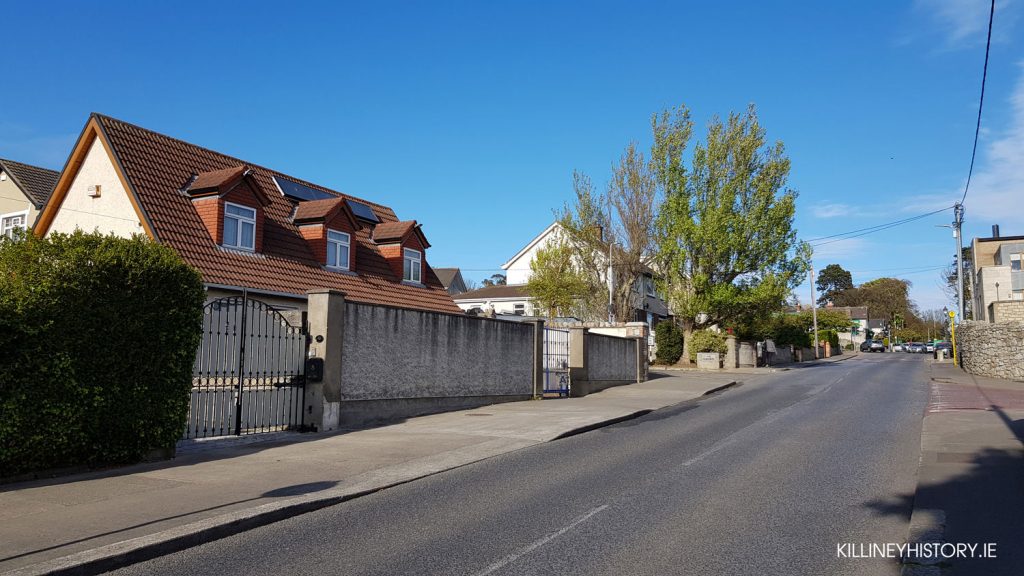
Wires Cut Explosives Used. It is estimated that several hundred men must have been engaged in the affair. All telephone wires and cables were cut and no communication could be affected by that means. Yesterday a large Post Office staff were engaged repairing the wires. Explosives must have been utilized to blow up the building as the broken window glass of the barrack was scattered on the road outside. Mrs. Bell who resides on Military Road said she heard a number of people passing to and fro outside her house, and on going to the door saw a number of men, one of whom pointed a revolver at her and commanded her to stand. She explained she was going to Mrs. Hurst at the barracks and the man told her not to mind as Mrs. Hurst was alright as she was going to Mrs. Wilson’s place. She was sure that over 100 men took part in the attack. They waited and watched the barracks burning for about an hour. The military did not arrive until 2:00 AM.
“They carried out their work” said Mrs. Bell “very determinedly, but without excitement and they were very civil”
A Constable’s Wife’s Story. Mrs. Wilson, wife of constable Wilson, Cabinteely, said she was awakened by a loud knocking at her door about 10:00 PM. A voice asked for her husband and being told he was not in went away a few minutes later. She heard that the barracks was on fire and she left the cottage which is next door to the barracks and went to Mrs. Bell’s with her baby. She saw men bringing Mrs. Hurst and her family to her house. She saw about a dozen men carrying bundles of straw into the barracks. Some had masks and all were armed. One of the men told her to make room for Mrs. Hurst and the children.

Pedestrians Held Up. Another Ballybrack resident stated that 40 or 50 men who arrived on bicycles took part in the attack. All the pedestrians at Ballybrack corner were ordered to stand in a row. He was placed along with them and they were kept waiting about 3/4 of an hour. Then they were ordered to go down Seafield Road and in five minutes they were told they could go. The men who held him up then apologized and rode away.
Mrs. Hurst’s Account. 10 Minutes To Get Away. Mrs. Hurst, wife of Sergeant Hurst, who up to the time of the evacuation had been in charge of the barracks, told an Irish Independent representative that about 9:50 PM a knock came to the door of the barracks and one of the children opened it. Two men, not masked, were at it and they asked for Sergeant Hurst. The child told them his father was at Cabinteely. One of the young men then asked to see Mrs. Hurst she came out and said goodnight and they returned it. Then one of them said “I’m very sorry but we have come to burn down the barracks. I will give you just 10 minutes to get out.” “I asked him to allow me to take out some of my good things.” continued Mrs. Hurst and he said “I will give you 10 minutes to get whatever you can.” I asked him if I could take out the piano, as it was a valuable one, but he said no, as it would take too long to remove it. He said he would give me every assistance to get out any things I liked, and he called over another young man and told him to give me every help.” Mrs. Hurst then took out some bed clothing and a sewing machine. She was then directed to go to Mrs. Wilson’s. Mrs. Hurst asked to be allowed to go to Mrs. Lawless, but the spokesman of the party said they had arranged that she should go to Mrs. Wilson. The men then brought Mrs. Hurst and her family to Mrs. Wilson and left them at the door.
The leader said to her: “We have no ill feeling towards and no ill feeling would be shown towards any neighbor who takes you in.” He parted good friends and said goodnight and shook hands with her. All the furniture has been destroyed. Mrs. Hurst is at present stopping with Mrs. Lawless, Shanganna Grove, and the children are with Mrs. Griffiths, Wattville. In the barracks at the time there were Mrs. Hurst, a daughter and three boys. A Dublin gentlemen on his way to the railway station about 10:15 said he and others were halted by two men and told to stand where they were for a few minutes. This they did. In a short time the barracks went on fire and there was a loud explosion. After some time they were told to go and their captors apologized for their detention and hoped they would not lose their train. In all, 36 men were held up at that particular point at the same time.
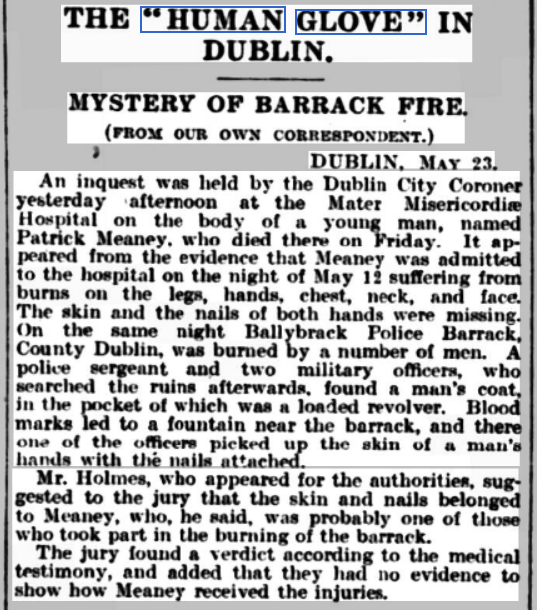
Trails of Blood. Along the footpath from the destroyed barracks on the corner of Wyattville and Ballybrack Road there was a trail of blood which stopped at a lamppost where there was a large pool. It is assumed one of the attackers must have sustained serious injury. A resident states that he saw a masked man hold up a motorcyclist with a trailer and direct him to a place where he would get instructions.
It was stated in Dublin that portion of a man’s hand was found in the immediate vicinity of the barracks. Another report states that a motorcyclist with sidecar was seen in Westmoreland St about 11:00 PM with two young men, one in the sidecar and one sitting behind, both bleeding and apparently in great pain. They were transferred to a cab and driven away but their destination has not transpired. A pool of blood marked the spot where the motorcycle pulled up.
William McCabe Fatally Shot at Strathmore Road
Mysterious Tragedy at Killiney. William J McCabe, head gardener in the employment of Rt. Hon. L. Waldron, P.C. was shot dead on Wednesday night on the Strathmore Road, Killiney. He had been visiting the gate lodge at Strathmore house and left for home at 10:00 o’clock. He was shot within 50 yards of the lodge. Mr. and Mrs. Coyle who occupy the lodge at Strathmore House, the residence of Mr. W.J. Bramley, a retired Indian judge, walked with deceased to the entrance gates and having bid him goodnight they retired. Within 10 minutes, Mrs. Coyle told an Irish Independent representative she heard shots close to the rear of the lodge on the Strathmore Rd. She could not say how many shots she heard probably, four or five. She and her husband went out to the roadway and about 40 or 50 yards from the lodge gates, and directly opposite the rear entrance to Palermo, the residence of Mr. Wilson, they saw a body lying on the left hand side of the road. They saw no one in the vicinity at the time. Going to the spot they found that the victim was their late visitor and he appeared quite dead.

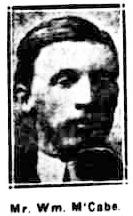
Instantaneous Death. Mr. Wilson (Wilkinson), Palermo, came on the scene. When the telephone was tried for medical and other assistance it was found that the wires had been destroyed over a considerable area. The body was afterwards removed by Mr. Wilson (Wilkinson) and Mr. and Mrs. Coyle to a green house in the grounds at Palermo. An examination showed that there was only one bullet wound on the body.
He was shot through the center of the forehead, the bullet lacerated the brain. Death must have been instantaneous. Dr. Pim, who resides in the locality, examined the body shortly after the occurrence. A large pool of blood about 40 yards from the lodge marks the spot where McCabe met his death. The distance between the lodge and Strathmore and Mr. Waldron’s gate is about a quarter of a mile. The body was removed yesterday to Mr. Waldron’s lodge.
A Theory. The fact that the tragedy occurred about the time of the burning of Ballybrack police barracks, about 3/4 of a mile away, when pedestrians were held up on various approaches, is responsible for the theory that he failed to answer a challenge or was accidentally shot as the result of the operation. Deceased was aged 39. He was a native of Kilcock, and unmarried, and he was resided with his sister at Mr. Waldron’s gate lodge. He had been about 10 years in Mr. Waldron’s employment. It is stated that deceased was engaged to be married. After the raid on the barracks parties of military were conveyed to the scene and scoured the countryside from about 2:00 to 4:00 o’clock. Several residences in Dalkey and Dalkey Hill were searched but no arrests were made.
The Inquest into the death of William McCabe
The article below which appeared in the Weekly Freeman on Saturday 22nd of May 1920 records the inquest.
Shot Dead at Killiney. County Dublin Gardener’s Tragically Sudden End. Incident at Inquest. William McCabe, head gardener of the Right Hon. Mr. Laurence Waldron, P.C. Marino, Killiney, was shot dead on the Strathmore Rd., Killiney at about the same time that the barracks at Ballybrack, County Dublin was destroyed about 10:00 o’clock on Wednesday night. He was about 39 years of age, unmarried and resided with his sister in the gate lodge attached to Mr. Waldron’s residence. He was a native of Kilcock, County Kildare. An attempt was made to telephone for medical and other assistance but this failed owing to the wires having been cut over a considerable area. At the inquest in the gate lodge of Marino the residence of the Right Hon. Laurence Waldron P.C. the jury found that death resulted from shock and haemorrhage following revolver shots wilfully administered. They found a verdict of murder against some person or persons unknown. They also tendered heartfelt sympathy to the father, sister and brother of the deceased and deplored the untimely death of a man universally respected in the neighbourhood. The Right Hon. Mr. Laurence Waldron deceased’s employer was present at the inquest. The father of deceased Mr. Robert McCabe who was present in court declared himself unable to view the remains of his son. Mr. Joseph Kyle (Coyle) Strathmore Lodge employed by Mr. W. Jennings Bramley said the deceased visited him about a quarter to eight Wednesday night and he left about 10:00 o’clock. He saw him as far as the gate lodge and bade him goodnight. Deceased went up the road and witness closed the gate. Witness then returned to his house and heard three or four shots. He ran along inside the wall and about 55 yards away he looked over it and saw deceased lying on the road. He got over the wall and put his arm under him and called him by his name three times but he did not answer. Replying to Mr. Holmes, Counsel for the Crown, he said when he jumped over the wall he looked down towards the sea and saw two men running away around the lamppost at the corner. Dr. Joshua Pim deposed to being summoned to the scene. His postmortem examination revealed the presence of four wounds, one in the head and three in the chest.

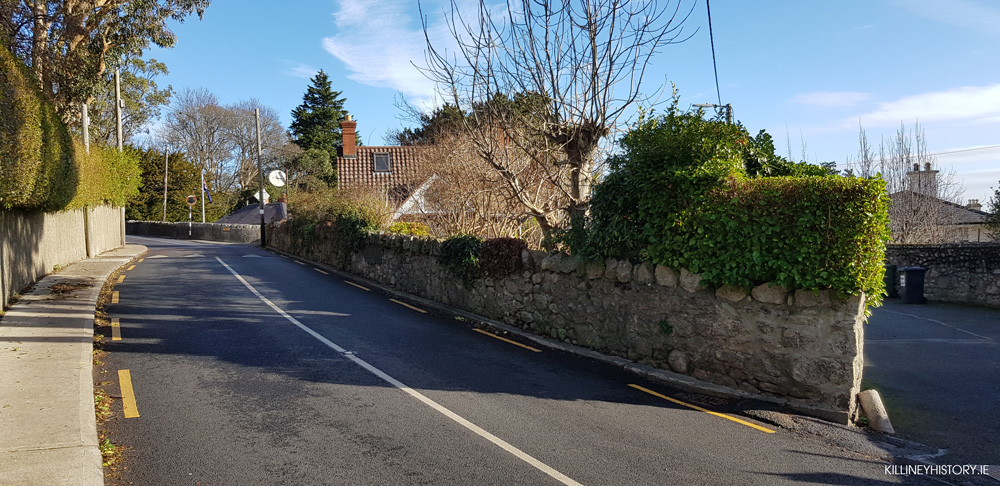
Henry Patrick Gallagher, Upper Dargle Road, Bray stated that on Wednesday night he was sitting on a seat opposite Strathmore Road shortly before 10:00 o’clock with Miss McAdams. Two men came along the road about 5 minutes to 10. One came and spoke to him and said he was very sorry to discommode them and said that they had better go down the road towards the station. Witness, with the girl, went down the road and the two men remained behind. The man who spoke wore a Macintosh. He couldn’t say if he had a revolver. Miss Ellen McAdams who was in company with the last witness corroborated. Mrs. Hurst, wife of Sergeant Hurst, who was living in Ballybrack barracks stated a party of men came up about 10 minutes to 10 and moved her out of the barracks and then set fire to it. Some had revolvers and some had not. Some were masked. Mr Holmes said if the jury were satisfied that the men in masks went out in connection with the burning of barracks and gave some order that McCabe either didn’t hear or didn’t carry out, and as a result was killed, there could only be one verdict, and that was of murder. This unexplicable and unnecessary crime could not have been committed by anybody who knew McCabe or who lived in the district.
Compensation for the McCabe family
With thanks to Pippa McIntosh for bringing this newspaper report to our attention. Irish Examiner Thursday, November 04, 1920
Robert McCabe, farmer, Kildare, claimed £750 compensation for the loss of his son, William J. McCabe, a gardener in the employment of the Hon. Lawrence Waldron, who was shot at Strathmore Road, Killiney on the night of May 12th, on the occasion of the burning of the Killiney Police Barracks. Counsel for the applicant said deceased was shot dead on coming out of a gatelodge at Strathmore Road at about 10 p.m., just at the time Ballybrack Police Barrack was being burnt.
The Recorder-There is no doubt he was not shot by the military.
Counsel said there was not, because he could produce evidence to show that precautions had been taken. The telephone and telegraph wires were cut, and scouts were thrown out for considerable distance all round, and he could produce a person who was challenged by these scouts.
The Recorder-It was a very cruel murder.

Counsel said nobody had a grudge against the deceased, who had no enemies. His father had a little farm of six acres in Co. Kildare, and the deceased sent him money from time to time. Mr. Waldron had increased his wages the previous week, and he had arranged for his father to come and live with him. The deceased was unmarried and his sister kept house for him. His wages were 50s per week, and he had a free house, fuel and vegetables. The applicant having being examined, the Recorder awarded him £500 and £100 to the deceased’s sister, to be levied off the County Dublin.
Memorial cross to William McCabe
We recently came across a transcription of a letter by an old Killiney resident, Bobby Chester, written to his sister in 1982 concerning his early days in Killiney c.1930’s. He describes a walk from Killiney beach to the village where he mentions houses and items of interest encountered on the way. He says in the letter:
‘The most direct way from the seashore to the village is by two steep laneways each containing a series of steps. No. 1 lane leads from the beach to one of the back entrances to Illerton near point 6 on my map. On a wall here may be seen a roughly carved cross. This marks the spot where a local man was shot by the IRA during the” troubles”. It was said he had acted as an informer to the Black and Tans against the IRA.’
This is the pedestrian right of way from the beach which exits close to the entrance to Strathmore. We believe he is actually referring to the shooting of William McCabe, the Marino gardener, which occurred in this area around the same time. It is unlikely that there were two shootings in this location during the War of Independence. The reference to the victim being an informer is most likely an embellishment of the story which grew legs over time. We have searched for the cross on Strathmore Road recently but unfortunately nothing has turned up, yet.
Article from An Phoblacht marking the 100th Anniversary in May 2020
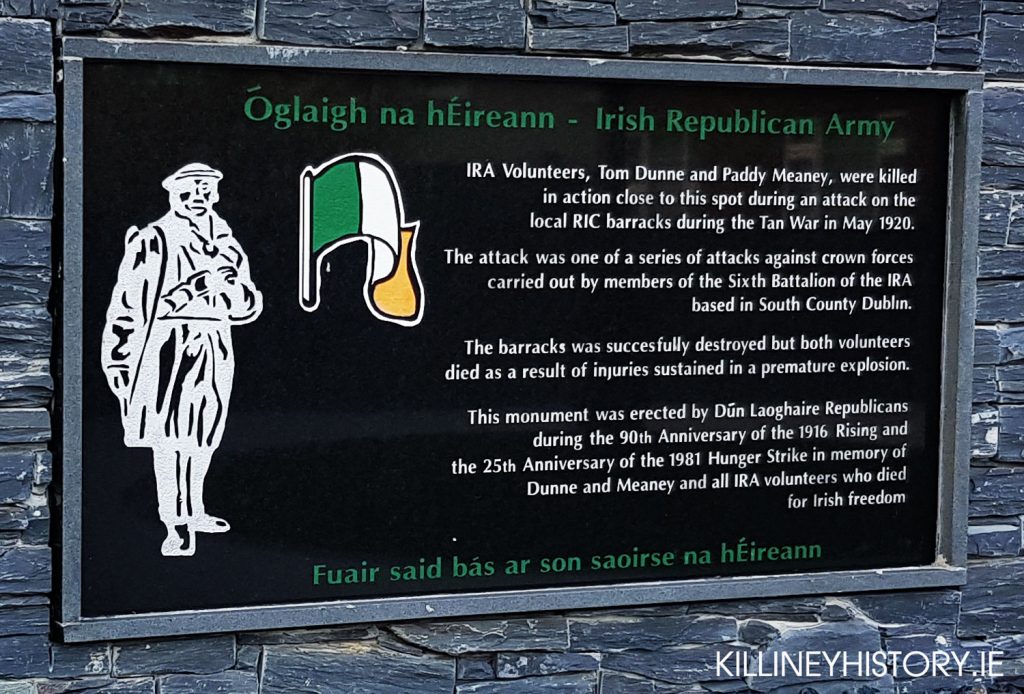
Volunteers of the 6th Battalion of the Irish Republican Army, based in south County Dublin, were sent out to destroy British bases in the area. Their objective was simple – destroy all Royal Irish Constabulary (RIC) and Dublin Metropolitan Police (DMP) barracks with the aim of preventing them being used to house Britain’s so-called ‘special forces’, the notorious Black and Tans. These attacks in the Dún Laoghaire area were but a few of hundreds of co-ordinated attacks that took place across the entire country on the same day with the same aim. In all, 70 barracks buildings and British Government offices were destroyed.
Volunteers Patrick Meaney (originally from County Carlow) and Thomas Dunne (from west Wicklow) joined with their comrades from the 6th Battalion and initiated attacks on Kill o’the Grange DMP barracks and Ballybrack RIC barracks.
Patrick Meaney and Thomas Dunne were admitted to the Mater Hospital and died there within days of the attack – Dunne on May 14th and Meaney on May 21st. Both were acknowledged as Volunteers of the Irish Republican Army and are honoured as such by republicans today.
